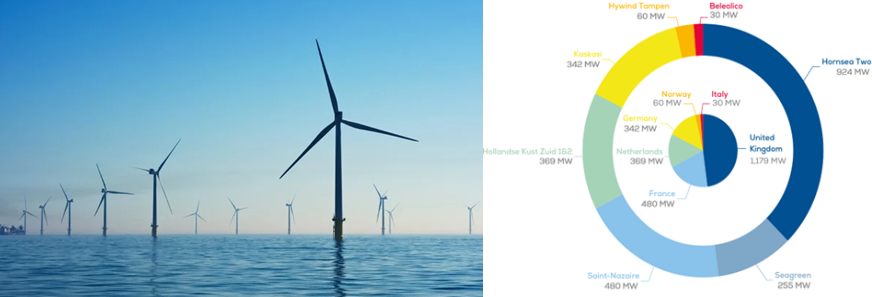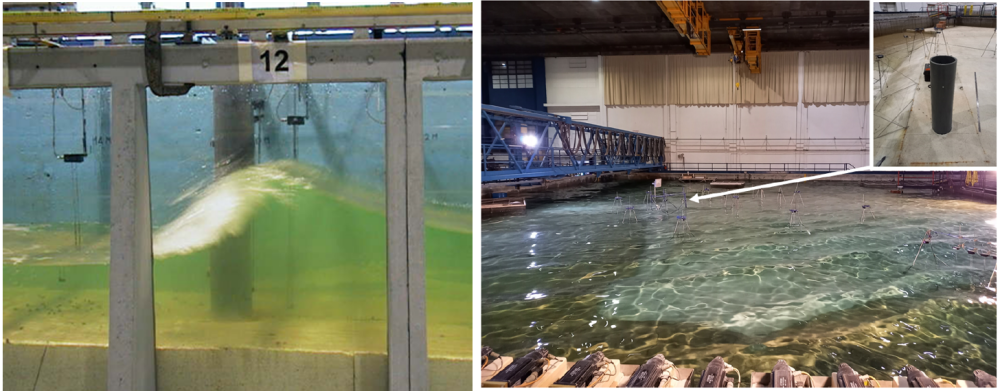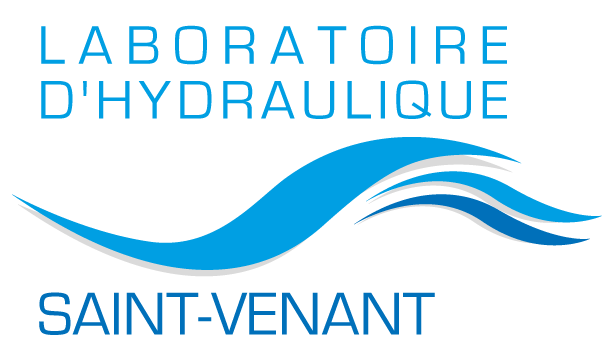Wave interaction with offshore wind turbine foundations in the coastal zone - effects of wave non-linearity, wave breaking and complex flow structure
Présentation
Durée : 3 years - Application deadline : 30 april 2024.
Objectives and methods
1. General context
This thesis aims to contribute to the highly dynamic development of offshore wind energy, in particular for fixed wind turbines (for water depths less than 50-60 m). Numerous wind farms have been installed worldwide in recent years. In Europe, the total installed power capacity of offshore wind turbines (OWT) reached 25 GW by the end of 2022, composed of 82% fixed wind turbines and 18% floating wind turbines [1]. During the year 2022, a total of 2.5 GW of new offshore capacity was connected to the grid in Europe (cf. fig. 1 and [1]). In France, the first offshore wind farm, composed of eighty 6 MW OWT (480 MW total power capacity), was commissioned in Saint-Nazaire (cf. fig. 1) and connected to the grid in 2022.

Figure 1. (left) Photo of the Saint-Nazaire offshore wind farm installed by EDF and operating since 2022 (80 x 6 MW OWT) (photo credit: Nicholas Doherty / Unsplash). (right) New offshore wind farms connected to the grid in Europe in 2022 (source: WindEurope [1]).
The design of OWT is a complex subject due to the range of loads that apply to the various parts of the system, namely the foundation, mast and turbine. These loads include hydrodynamic forces (due to ocean waves and/or currents), aerodynamic forces (due to winds), forces from mooring lines (for floating OWT) or from the seabed (for fixed OWT), etc. The effects of the wind turbine controller, which adapts the turbine behaviour as a function of local wind and hydrodynamic conditions, also need to be taken into account.
In response to these loads, the motion (static and dynamic) of the “foundation+OWT” ensemble is complex, with different movements and/or deformations at different time scales, potentially with non-linear effects and the excitation of resonant modes. In particular, the hydro-elastic behaviour of the structure under wave action is relatively little studied in the existing scientific literature.
The present PhD project aims at improving our knowledge and modelling capabilities of wave-structure interaction for OWT foundations, mainly of fixed type (e.g. monopiles), with particular attention on the complex flow patterns near the foundation, the creation of vorticity, viscous and turbulent effects in strongly non-linear and breaking wave conditions, and the rigid-mode and hydro-elastic responses of the structure to these wave loads.
2. Research objectives
This thesis subject pursues research undertaken at the LHSV in recent years on OWT support structures, using both modelling and numerical simulations and laboratory tests on reduced-scale models. The main objectives of the thesis are to improve our knowledge of both the dominant physical processes and the capacity to model them numerically, concerning the following aspects:
(a) the hydrodynamics in the vicinity of OWT foundations, for fixed monopile foundations (e.g. gravity base structure (GBS) or jacket type) in finite water depth (typically less than 50 m), taking into account the non-linear effects of waves for design cases in extreme waves. Wave breaking of steep waves, causing transient but very intense impact pressures and forces on the foundation, will be studied too. The focus will be on the 3D structure of the wave-induced flow around the foundation, the characterisation of the vorticity field induced by the presence of the structure, and the possible breaking of the strongest waves.
(b) the loads on the structure, including the pressure map on the structure’s walls, total forces and moments, and the possibility of estimating them from the incident hydrodynamic conditions, using simulation methods and tools of increasing complexity. In particular, the non-linear components of the loadings (i.e. of orders 2 and 3 at least) and the impulsive effects induced by breaking wave impacts will be characterised.
(c) the dynamic response of the structure to these loads. This response will be first studied considering a rigid mode behaviour. In the second step, the hydro-elastic behaviour, considering the deformation modes of the structure, will be addressed.
3. Methods and tools
Two complementary approaches will be used:
(a) numerical simulations, using fluid mechanics computational codes developed within a fully non-linear potential flow (FNPF) framework, and CFD-type codes solving the Navier-Stokes equations in the vicinity of the structure to characterise the importance of viscous, turbulent and vorticity effects. The LHSV uses either in-house simulation codes or those provided by EDF. These models include numerical wave tanks based on the FNPF approach, e.g. seine3D [2, 5] and whispers3D [3], and CFD software, e.g. code_saturne [4], which can be used as standalone tools, or chained/coupled [5] (see fig. 2). Open-source tools widely used for this type of application (e.g. OpenFOAM) could also be tested.

Figure 2. Numerical simulations of non-linear waves impacting a monopile structure. Snapshots of recent high-fidelity simulations done at the LHSV: (left) regular non-breaking wave simulated with seine3D [5]; (right) focused breaking wave simulated with code_saturne [4].
The results of these fine-scale simulations, which provide a detailed description of the spatio-temporal structure of the flow, will be used to generate a database to improve more simplified load models found in engineering-oriented tools, in particular the DIEGO hydro-aero-servo-elastic code used operationally by EDF R&D [6, 7]. Here again, open-source codes could be considered as well (e.g. openFAST).
(b)laboratory experiments. At the beginning of the thesis, a review of the available experimental results (e.g. [7, 8, 9]), some of which have been carried out at EDF R&D and the LHSV [10] (see fig. 3), will be used to characterise the dominant physical phenomena and to begin validating the numerical models. This review will also be used to define a series of laboratory experiments, a priori in a wave flume at the LHSV in Chatou to fill gaps in existing knowledge. During this experimental campaign, various quantities will be measured, including (i) the wave field (via a set of wave probes and possibly video techniques), (ii) the hydrodynamics around the structure (using Particle Image Velocimetry (PIV), either in 3D or as a set of 2D vertical planes, for example), (iii) the loads exerted on the structure and (iv) the structure’s motion. Pressure and/or force sensors will be installed on the scale model of the tested foundation. Establishing the experimental set-up, selecting the test conditions, choosing and calibrating the set of sensors and measurement instruments, etc. will be part of the thesis project, in collaboration with EDF and LHSV staff in charge of the experimental facilities.

Figure 3. (left) Experimental test of a breaking wave impacting a monopile (tests done at EDF R&D LNHE, from [10]); (right) Experimental setup of 3D wave propagation and breaking over a variable bathymetry, with the inset showing the cylindrical model of a monopile (tests done within the 3DWaveBI project in the LHSV at EDF Chatou Lab).
The experimental and numerical parts of the work in this thesis will be roughly balanced (about 50% each). Using these complementary approaches, significant progress in the understanding of complex wave-structure interactions in severe wave conditions (up to wave breaking) is expected.
4. Deliverables
- The findings of the research will be published in top-level journals (e.g. J. Fluid Mech., Coastal Eng., Ocean Eng., etc.) and presented at international conferences in the field of ocean and coastal engineering, offshore wind energy, etc.
- The experimental database from the wave flume campaign will be made available to the scientific community, which is expected to increase the dissemination of results and the international impact of this research.
- Experimental and high-fidelity simulation results will be used to improve the capabilities of engineering-type software used in the OWT field, in particular, the DIEGO code of EDF R&D [6, 7].
5. References
[1] Wind Energy. Wind energy in Europe - 2022 Statistics and the outlook for 2023-2027, Available online: https://windeurope.org/intelligence-platform/product/wind-energy-in-europe-2022-statistics-and-the-outlook-for-2023-2027/#overview (accessed 19/12/2023)
[2] Harris, J.C., Dombre, E., Benoit, M., Grilli, S.T., Kuznetsov, K.I. (2022) Nonlinear time-domain wave-structure interaction: a parallel fast integral equation approach. International Journal for Numerical Methods in Fluids, 94(2), 188-222.
[3] Zhang, J., Benoit, M. (2021) Wave-bottom interaction and extreme wave statistics due to shoaling and de-shoaling of irregular long-crested wave trains over steep seabed changes. Journal of Fluid Mechanics, 912, A28.
[4] Batlle Martin, M., Harris, J.C., Filipot, J.-F., Hulin, F., Tassin, A., Renaud, P. (2023) Deep water focused breaking wave loads on a fixed cylinder. Coastal Engineering, 186, 104397.
[5] Landesman, P., Harris, J.C., Peyrard, C. Benoit, M. (2024) Wave-structure interaction by a two-way coupling between a fully nonlinear potential flow model and a Navier-Stokes solver. Ocean Engineering, submitted.
[6] Rongé, E., Peyrard, C., Venugopal, V., Xiao, Q., Johanning, L., Benoit, M. (2023) Evaluation of second and third-order numerical wave-loading models for floating offshore wind TLPs. Ocean Engineering, 288, 116064.
[7] Peyrard, C., Benguigui, W., Barcet, M., Robaux, F., Benoit, M., Teles, M. (2023) Modeling FOWT hydrodynamic behavior with comparison to basin test experiments. Proc. 33rd International Ocean and Polar Engineering Conference (ISOPE'2023), 19-23 June 2023, Ottawa (Canada). Paper number: ISOPE-I-23-039.
[8] Dadmarzi, F.H., Thys, M., Bachynski, E.E. (2019) Validation of hydrodynamic loads on a large-diameter monopile in regular waves. in: International Conference on Offshore Mechanics and Arctic Engineering, ASME. pp. 1–8. doi:10.1115/OMAE2019-95929.
[9] Suja-Thauvin, L., Bachynski, E.E., Pierella, F., Borg, M., Krokstad, J.R., Bredmose, H. (2020) Critical assessment of hydrodynamic load models for a monopile structure in finite water depth. Marine Structures, 72, 102743.
[10] Luck, M., Benoit, M. (2004) Wave loading on monopile foundation for offshore wind-turbines in shallow-water areas. Proc. 29th Int. Conf. on Coastal Eng. (ICCE'2004), 19-24 September 2004, Lisbon (Portugal), pp 3992-4004.
Thesis supervisor(s)
Dr. Jeffrey Harris (ENPC & LHSV), jeffrey.harris@enpc.fr
Dr. Michel Benoit (EDF R&D & LHSV), michel.benoit@edf.fr
Other researchers from the LHSV lab will be involved in the PhD research project, including Dr. Marissa Yates (ENPC), Christophe Peyrard (EDF R&D) and Dr. Sébastien Boyaval (ENPC).
Working environment
The thesis will be carried out in the LHSV laboratory (https://www.saint-venant-lab.fr/) on the EDF Lab Paris-Chatou site, where both the LHSV and the LNHE of EDF R&D are located. This site is situated on an island of the Seine River (“Ile des Impressionnistes”) about 10 km from Paris. It is easily accessible by public transportation (RER train line A, “Rueil-Malmaison” stop + 12 min walk or bus shuttle).
The experimental campaign will take place in the research facilities of EDF R&D (2 wave basins, 2 wave flumes + several tanks for river applications) located on the same site. These facilities are equipped with computer-controlled wavemakers, able to generate various types of waves, including regular, irregular and focused wave trains.
The candidate will also have access to the high-level computing facilities of EDF to run the numerical simulations.
Associated project partner:
The doctoral offer is co-developed with a R&D and industrial partner (bringing co-funding): EDF R&D Laboratoire National d’Hydraulique et Environnement (LNHE), in Chatou (Paris area), France. The LHNE and LHSV work in close collaboration, sharing offices, experimental facilities and some computational codes. This partnership also opens the possibility of having contacts and discussions with engineers from EDF Renouvelables (https://www.edf-renouvelables.com/), the company of the EDF group in charge of all offshore wind projects for the EDF group (including the Saint-Nazaire offshore wind farm).
Secondments:
The candidate may have the opportunity to spend a period of at least 3 months in a partner laboratory outside of France. Contacts have been established with the team of Pr. Antonio Souto-Iglesias at Universidad Politecnica de Madrid (UPM), Spain, who accepted to host the visit of the PhD student. In the frame of this collaboration, the PhD candidate will be able to work closely with a PhD student currently working at the UPM on close topics.
Pr. Souto-Iglesias (https://www.researchgate.net/profile/Antonio-Souto-Iglesias) is the Director of Model Basin Research Group (CEHINAV), Department of Naval Architecture, Shipbuilding and Ocean Systems (DACSON), and Deputy Director for Academic Strategy of the Naval Architecture School (ETSIN) (see: http://canal.etsin.upm.es).
ENPC and UPM are both active members of the EELISA European University and network (https://eelisa.eu/).
Description of the project and the candidates’ eligibility criteria:
This position will be part of the EU-funded project MISCEA, which is an ambitious inter- and multidisciplinary Doctoral Training Network under the Horizon-Europe Marie Skłodowska-Curie Actions. You should find complementary information here:
- https://euraxess.ec.europa.eu/jobs/187161
- https://www.miscea-program.fr/wp-content/uploads/2024/01/ESR03_MISCEA_EURAXESS-LHSV_Wave-interaction-with-offshore-wind-turbine-foundations.pdf
PhD candidates’ can be of any nationality but you have to meet these eligibility criteria:
- Not being a current employee working at ENPC.
- Not having resided or carried out their main activity (work, studies, etc) in France for more than 12 months during the past 36 months immediately before the deadline of the MISCEA Programme's call. Compulsory national service, short stays such as holidays and time spent as part of a procedure for obtaining refugee status under the Geneva Convention are not taken into account.
- Holding a Master’s degree (or about to obtain one) or having a University degree equivalent to a European Master’s degree (5-year duration) at the deadline of the MISCEA Programme's call.
- Researchers must be doctoral candidates, i.e. not already in possession of a doctoral degree at the deadline of the co-funded programme's call. Researchers who have successfully defended their doctoral thesis but who have not yet formally been awarded the doctoral degree will NOT be considered eligible.
- Signing a declaration of the veracity of the information provided (Declaration of honour, free of form).
If you comply with the eligibility criteria and you wish to submit your application, you must:
- Contact the thesis supervisor and explain your thesis project to her/him so that she/he validates your application via a letter of acceptance.
- Submit a 5-pages thesis proposal under the proposed research areas, with the agreement of the future supervisor + 1 page cover letter with: the relevance of your educational/professional background to carry out your thesis topic.
- The applicant will have to complete an ethics checklist based on ethics guidance from the HorizonEurope programme guide.
- English-translated transcripts from the master’s degree or equivalent.
- Any specific requirements of the Doctoral School corresponding to the targeted MISCEA fellowship offer.
- English curriculum vitae, including information about the level on English language knowledge.
- One letter of reference, at least.
See mandatory templates for your application and recruitment conditions on the Applicant’s guide on the MISCEA website (link).
Then your candidature is complete, please send inquiries and applications to miscea-program@enpc.fr
Requirements
Research Field: Fluid mechanics – Water waves and hydrodynamics - Ocean and coastal engineering – Offshore wind energy – Numerical simulations - Experimental hydraulics
Education Level: Master Degree or equivalent
Skills/Qualifications: Candidates are expected to possess skills in fluid and structure mechanics, in particular for free surface waves and associated hydrodynamics. Knowledge of fluid- or wave-structure interaction (if possible covering hydro-elasticity) will be appreciated. As the thesis will involve both numerical simulations with various computational codes and experiments in a wave tank, the candidates should be comfortable and willing to work on scientific computing, and take part in or carry out experiments on a scale model (including the stages of defining the experimental model and the metrology, processing and analysing the results, etc.).
Languages: English
Level: Excellent
Ce poste vous intéresse ?
Postulez en remplissant le formulaire ci-dessous.
Important : pour faciliter leur traitement, nous n'acceptons que les candidatures électroniques.
Pour candidater, merci de remplir le formulaire ci-dessous.
Toutes les informations fournies par vous resteront confidentielles et ne seront ni divulguées ni mises à disposition d’un autre organisme sans accord préalable écrit de votre part. Selon la loi informatique et libertés, vous disposez d’un droit d’accès et de rectification aux données vous concernant.

Mentions légales / Politique de confidentialitéX
